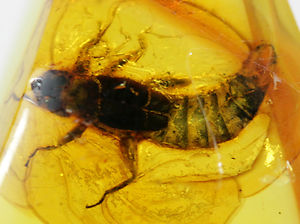 Baltic amber is a fossilized coniferous tree resin that contains high values of succinic acid – up to 8%. Succinate gives Baltic amber the status of being one of the world’s finest amber gems, because of the other 100 fossil resins, none contains more than 3% succinic acid. However, some of them can be worked as amber.
Baltic amber is a fossilized coniferous tree resin that contains high values of succinic acid – up to 8%. Succinate gives Baltic amber the status of being one of the world’s finest amber gems, because of the other 100 fossil resins, none contains more than 3% succinic acid. However, some of them can be worked as amber.
Amber is found underwater or underground in natural deformed forms such as stalactites, drops, fillings in the crevices of resinous trees. The revealing forms of internal natural casts of amber show the proof of prehistoric trees of unimaginable sizes. Some amber pieces weigh 2 to 3 kg, while the biggest known amber piece weighs 9.75 kg. Due to climate changes, amber can be found in different shapes and sizes from boulders to rounded grains.
Natural weathering adds more beauty to the amber stone, compared to the pieces found underwater or underground. That is why the Polish Baltic amber is more beautiful than the Sambian amber found in mines that has been below sea level for 40 million years, in the “blue earth” environment.
So what is the origin of amber’s name? The English “amber” derives from the Arabic word of “anbar”, also known as “ambar” in Medieval Latin or “ambre” in Old French, and at first described a precious type of oil derived from sperm whales, which is now known as “ambergris”. After the year 1400, it was used to describe fossil resins and it has stayed that way until the present day. Both ambergris and amber were confusing, because they would be found in the same places, washed on shores. While ambergris is less dense than water and floats on it, amber is less dense than a stone, but denser than water, so it sinks. The “ambar” word was brought by the Crusaders. The French gave a bit of help in distinguishing the two substances: ambre gris (gray amber) became ambergris and ambre jaune (yellow amber) became “amber”, the fossil resin known today.
In the 4th century BC, Theophrastus makes his first historical mention of amber. The Greeks called it “electron” or “formed by the sun” and it was strongly linked to the Greek mythology of the Sun God Helios, also known as Elector or the Awakener. The Greek legends speak of the murder of Phaeton, Helios’ son and how his mother and sisters grieved his death, their tears turning into amber stones.
Electricity and electron derive from the Greek word for amber, when William Gilbert showed how amber could attract other substances. The first analysis of elementary charges of amber was in 1891, by Irish physicist George Stoney.
 The first mention of amber inclusions was found in Pliny the Elder’s work, Naturalis Historia, where he correctly theorized that somewhere in the beginning, amber was in a liquid state so the insects became trapped in it. He named it succinum or gum-stone, so later on the name was used to describe the succinic acid or the succinite, a term describing a particular kind of amber by James Dwight Dana.
The first mention of amber inclusions was found in Pliny the Elder’s work, Naturalis Historia, where he correctly theorized that somewhere in the beginning, amber was in a liquid state so the insects became trapped in it. He named it succinum or gum-stone, so later on the name was used to describe the succinic acid or the succinite, a term describing a particular kind of amber by James Dwight Dana.
When heated, amber softens and eventually burns, leading Germanic civilizations to call it “burn stone” or “barnsteen”, “Bernstein”. Later on, the Polish named it “bursztyn” and the Hungarians, “borostyan”. Heated in temperatures above 200°C, amber is decomposed into amber oil. What remains is a black residue called amber colophony or amber pitch. If dissolved in turpentine oil or linseed oil, it turns into amber varnish or amber lac.
Amber from the Baltic shores has been traded since ancient times, forming the Amber Road, while on the mainland was traded 2000 years ago. The natives here called it “glaes”, similar to glass. The Baltic Lithuanian name for amber is “gintaras”, while the Latvian is “dzintars”. Along with the Slavic term of “jantar” and the Hungarian gyanta (meaning resin) this originates from the Phoenician “jainitar” – sea resin. Today, the Slavic languages of Russian and Czech use the old Slavic name, while the Polish people rarely use “jantar”, although correct, but instead refer to amber as “bursztyn”, the German term.
Comments
No posts found



